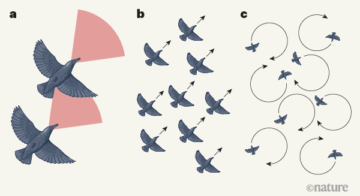Cynthia and Charles Reichhardt in Nature:
 Strongly non-reciprocal interactions and non-conservative forces can arise in social interactions, such as those that occur when pedestrians avoid each other, or when birds fly together as a flock3. These systems are examples of ‘active matter’, in which each element (a person or bird, in our examples) contains an internal energy source that injects energy into the system by enabling each element to move under its own propulsion4. By contrast, ordinary non-active matter is purely passive, such as a leaf drifting on a river in response to the underlying currents.
Strongly non-reciprocal interactions and non-conservative forces can arise in social interactions, such as those that occur when pedestrians avoid each other, or when birds fly together as a flock3. These systems are examples of ‘active matter’, in which each element (a person or bird, in our examples) contains an internal energy source that injects energy into the system by enabling each element to move under its own propulsion4. By contrast, ordinary non-active matter is purely passive, such as a leaf drifting on a river in response to the underlying currents.
Let’s consider the example of non-reciprocal interactions between flocking birds (Fig. 1a). To maintain a flocking arrangement, each bird adjusts its flight on the basis of the movement of the other birds in its immediate vicinity. Bird eyes, however, did not evolve to provide vision in all directions simultaneously. Instead, each bird responds only to other birds within its forward cone of vision5. If bird A is in the vision cone of bird B, then B responds to the motion of A; but if B is outside the vision cone of A, then A does not respond to the motion of B. In other words, the equivalence of action and reaction is lost.
More here.
